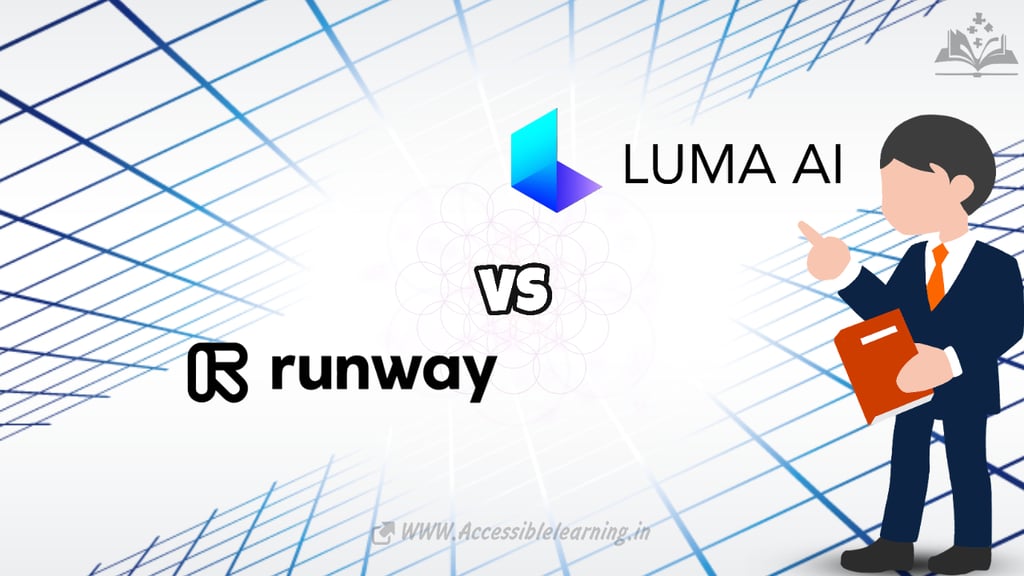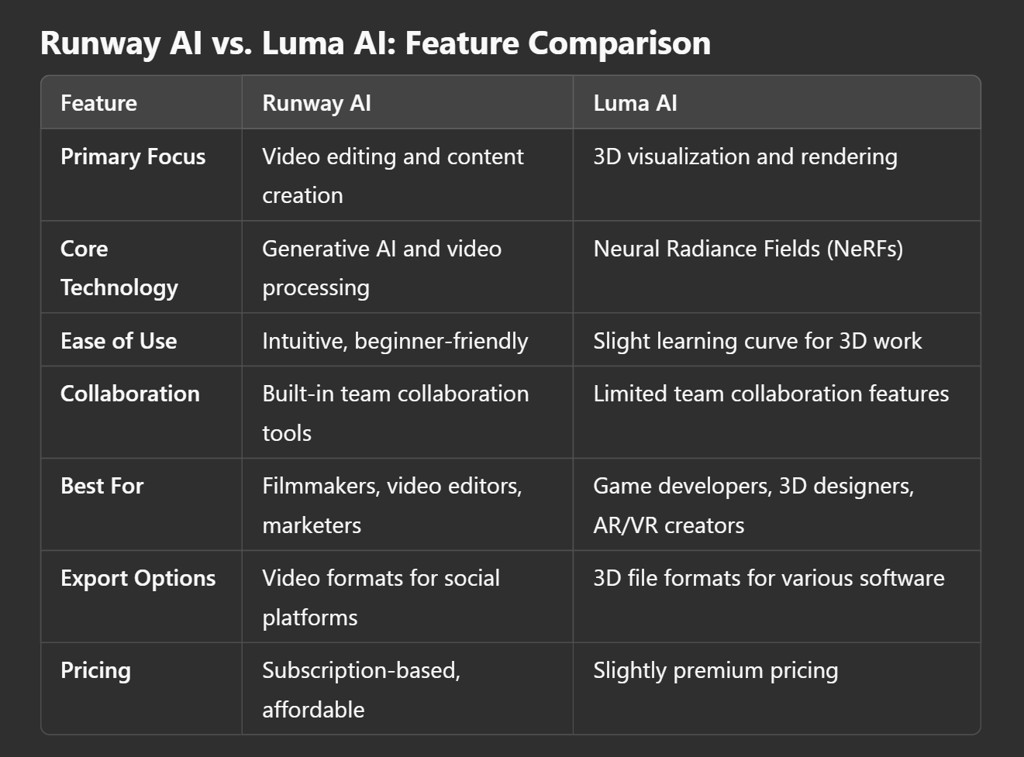
Runway AI or Luma AI: Which is Right for Your Project?
Explore the in-depth comparison between Runway AI and Luma AI, two cutting-edge AI tools revolutionizing video editing and 3D visualization. Discover their features, strengths, limitations, pricing, and use cases to determine the best fit for your creative needs.
AI/FUTUREEDITOR/TOOLSEDUCATION/KNOWLEDGEAI ART TOOLS
Sachin K Chaurasiya
1/11/20255 min read


Artificial intelligence (AI) tools are revolutionizing industries worldwide, and creative fields like video production and 3D visualization are no exception. Two prominent players in this domain are Runway AI and Luma AI. Both platforms offer innovative solutions but cater to slightly different needs. Let’s dive deep into a detailed comparison of these tools to help you understand their unique strengths and choose the one that best suits your requirements.
What is Runway AI?
Runway AI is a versatile platform that primarily focuses on video editing, content creation, and generative AI solutions. Designed for creators, filmmakers, and editors, Runway AI leverages advanced machine learning algorithms to simplify complex editing tasks.
Key Features
Text-to-Video Generation: Create videos from scratch using textual descriptions, allowing creators to bring their ideas to life without filming.
Green Screen (Background Removal): Remove or replace video backgrounds effortlessly, making it ideal for VFX and compositing work.
Video Inpainting: Seamlessly edit or remove unwanted objects from videos while maintaining high-quality visuals.
AI-Powered Effects: Apply cinematic effects, enhance colors, or stylize footage with AI-driven filters.
Collaboration Tools: Runway AI includes features that facilitate team collaboration, enabling multiple users to work on a single project.
Real-Time Preview: View changes instantly while editing, ensuring a smooth workflow and reduced iteration time.
Multi-Format Export: Export videos in various formats optimized for platforms like YouTube, Instagram, and TikTok.
Best Use Cases
Creating promotional videos and social media content.
Simplifying post-production tasks for filmmakers.
Experimenting with creative storytelling through AI-generated visuals.
Enhancing e-learning videos with engaging effects and backgrounds.
Strengths
Ideal for non-technical users.
Wide range of creative tools for video production.
Fast and efficient for on-the-go editing.
Supports creative flexibility with AI-driven features.
Limitations
Limited capabilities in 3D rendering.
May not satisfy the needs of AR/VR developers.
Dependency on an internet connection for advanced features.
Industry Trends Driving Adoption
Runway AI aligns with the broader trend of making video editing accessible to non-professionals. As social media platforms like TikTok, Instagram, and YouTube demand constant content creation, tools like Runway AI empower creators with minimal technical knowledge to produce professional-grade videos. The integration of text-to-video and generative AI capabilities ensures creators can stay ahead in a fast-paced digital ecosystem.
Emerging Competition & Integrations
The platform faces growing competition from similar AI-powered video tools like Pictory, Synthesia, and Descript. However, its ability to integrate with platforms like Premiere Pro and After Effects gives it an edge for professionals working within established workflows.
Future Outlook
Likely to expand into more advanced generative AI features, such as creating entire scenes or interactive storytelling elements.
Could explore integrations with AI voiceover tools for a seamless video production pipeline.
Expansion into more affordable pricing tiers for individual users could attract hobbyists and freelancers.
Pricing Models & Accessibility
Subscription tiers cater to varying needs, with entry-level plans for individual creators and advanced tiers for businesses.
Free trial available, making it accessible for users to experiment before committing.


What is Luma AI?
Luma AI specializes in 3D visualization and photorealistic rendering. Unlike Runway AI, which leans more toward video editing and effects, Luma AI excels in creating immersive 3D content using Neural Radiance Fields (NeRFs) technology.
Key Features
NeRF Technology: Generate lifelike 3D models from simple 2D images, enabling highly realistic digital recreations of objects and scenes.
Photorealistic Rendering: Achieve stunningly realistic textures, lighting, and depth in 3D visualizations.
3D Object Capture: Use your smartphone to scan objects or environments, which are then transformed into detailed 3D assets.
Real-Time Editing: Modify and enhance 3D models directly within the platform.
AR and VR Integration: Perfect for developers and designers working on augmented and virtual reality projects.
Cross-Platform Compatibility: Export models to various 3D software like Blender, Unity, and Unreal Engine.
Cloud-Based Processing: Leverage powerful cloud servers to process complex 3D data quickly and efficiently.
Best Use Cases
Game design and asset creation.
Architectural visualization and interior design.
E-commerce applications requiring realistic 3D product models.
Augmented reality (AR) and virtual reality (VR) content development.
Creating digital twins for industrial or educational purposes.
Strengths
Exceptional photorealism in 3D models.
Perfect for immersive and interactive projects.
Cutting-edge NeRF technology for precise 3D visualization.
Supports seamless integration with professional 3D tools.
Limitations
Less intuitive for beginners unfamiliar with 3D workflows.
Focuses primarily on 3D and may lack broader creative tools like video editing.
Requires high-performance devices for some features.
Industry Trends Driving Adoption
Luma AI is part of the digital twin revolution, where industries replicate real-world objects or environments in digital form. Its NeRF technology supports this shift, enabling sectors like e-commerce, real estate, and entertainment to showcase highly realistic 3D models. This approach also integrates well with the growing popularity of the metaverse and immersive experiences.
Emerging Competition & Integrations
Luma AI competes with tools like RealityCapture and Polycam, but its NeRF-driven approach is a game-changer. Partnerships with AR/VR platforms and 3D engines like Unity and Unreal make it a preferred choice for immersive experience developers.
Future Outlook
May leverage advancements in NeRF technology to offer real-time 3D rendering at even higher resolutions.
As AR and VR adoption increases, Luma AI could expand into consumer-friendly tools for hobbyist creators or educational use.
Potential to explore partnerships with industries like healthcare and engineering for more complex applications.
Pricing Models & Accessibility
Slightly premium pricing due to its specialized 3D focus, though free trials or limited features might be available.
Appeals to professionals who require precision and high-quality outputs.


Which One Should You Choose?
The decision between Runway AI and Luma AI depends largely on your specific needs and expertise.
Choose Runway AI if you are a content creator, filmmaker, or marketer seeking a tool for video editing and AI-driven effects. It’s an excellent choice for simplifying post-production workflows and creating engaging videos quickly.
Choose Luma AI if you work in 3D visualization, game design, or AR/VR development. Its ability to produce photorealistic 3D assets and integrate with immersive technologies makes it the go-to tool for professionals in these fields.
Runway AI and Luma AI represent the forefront of AI-driven tools for creative professionals. While Runway AI shines in video editing and content creation, Luma AI dominates the 3D visualization and AR/VR space. By understanding their strengths, limitations, and target audiences, you can make an informed choice to enhance your creative projects.
Both platforms showcase the incredible potential of AI in transforming creative workflows. Whether you’re a filmmaker looking to simplify your post-production process or a 3D artist aiming to create lifelike digital assets, these tools open new doors to innovation and efficiency. The future of creativity is here, and tools like Runway AI and Luma AI are paving the way.
Subscribe To Our Newsletter
All © Copyright reserved by Accessible-Learning Hub
| Terms & Conditions
Knowledge is power. Learn with Us. 📚


